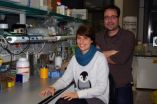(Press-News.org) The researcher Manuel Palacín, head of the Heterogenic and Multigenic Diseases lab at the Institute for Research in Biomedicine (IRB), in Barcelona, is among the world's experts in HATs (heteromeric amino acid transporters).
In humans, there are eight HAT molecules. These are associated, for example, with the following: rare diseases called aminoacidurias, such as lysinuric protein intolerance and cystinuria; the development of infections caused by the Kaposi sarcoma virus; various types of cancer; and relapse in cocaine use. HATs are, as the name implies, amino acid transporters, and they exert their action in the cell membrane. Because of their nature, they are extremely difficult to crystallize and consequently no structural data are available for these molecules at the atomic level. However, for rational drug design this information is imperative.
A study published this week in the journal Proceedings of the National Academy of Sciences USA (PNAS) has revealed the first structure of one of the eight HATs. Achieved through collaboration between biochemists at IRB, experts in electronic microscopy at the University of Bern, and computational biologists in the Joint IRB-BSC Programme, this breakthrough paves the way for further research into the functions of the other seven HATs and the resolution of their structures. Moreover, this study provides the first sufficiently detailed structural data to tackle their inhibition through drugs.
HATs and human pathologies
HAT proteins are formed by two parts or subunits, a light one which serves to transport amino acids and a heavier one that allows movement of the complex to the cell membrane, conferring it stability. In humans, six transporters form a complex with 4F2hc, while two do so with rBAT, thus totalling eight HATs. "They are mini machines that are inserted into the membrane and are in constant movement, engulfing amino acids from the extracellular space and releasing them in the cytoplasm or vice-versa," explains Palacín. "We knew the structure of one of the parts. Now, for the first time, we have the low resolution of the entire complex," he says.
The study, whose first four authors include the post-doctoral researcher Albert Rosell and the PhD student Elena Álvarez-Marimon at IRB Barcelona, describes the structure of the 4F2hc/LAT2 complex. "We chose this complex because it shows the highest stability among human HATs and would allow a greater chance of tackling its structure. The next step is to move onto its atomic resolution," explains Rosell. "Resolution at this level, at the highest definition, will help us to study the details of how "the machine" works and to gain a greater knowledge regarding the precise drug targets," add the scientists.
Only some HATs are associated with diseases. The 4F2hc/LAT1 and 4F2hc/xCT complexes are overexpressed in many kinds of cancer. "We have better and more detailed knowledge about the complexes and so we are providing new options by which to deal with cancer," says Manuel Palacín. The lab also focuses on aminoacidurias. Mutation in the 4F2hc/y+LAT1 complex causes lysinuric protein intolerance, a rare disease with 200 known cases. Finally, mutations in the rBAT/b(0,+)AT complex lead to cystinuria, a condition with an estimated incidence of one case per 7,000 births.
Manuel Palacín's basic research into HATs seeks to identify new therapeutic targets and to improve diagnostic tools for all conditions that involve HATs, with a special focus on aminoacidurias.
The study started as part of the European project EDICT (European Drug Initiative on Channels and Transporters), a consortium comprising 21 groups and funded by 11 million euros, which aims to increase the database of membrane protein structures. In 2008, at the beginning of the project, about 100 membrane protein structures were known. Today, this number has tripled, Palacín's group having contributed two of these new structures.
INFORMATION:
Reference article:
Structural bases for the interaction and stabilization of the human amino acid transporter LAT2 with its ancillary protein 4F2hc
Albert Rosell, Marcel Meury, Elena Álvarez-Marimon, Meritxell Costa, Laura Pérez-Cano, Antonio Zorzano, Juan Fernández-Recio, Manuel Palacín and Dimitrios Fotiadis
Proceedings of the National Academy of Sciences USA (PNAS) Early Edition 10 February 2014, doi:10.1038/nbt.2831
First observation of a human HAT, key proteins in numerous pathologies
HAT amino acid transporters are involved in pathologies such as aminoacidurias, cancer, viral infections and cocaine addiction
2014-02-11
ELSE PRESS RELEASES FROM THIS DATE:
Rare cancers: the challenge of accurate diagnosis -- press release
2014-02-11
Brussels, Belgium, 11 February 2014 -- Inaccurate diagnosis is a major obstacle for the proper treatment of patients with rare cancers. A Consensus on Improving the Pathologic Diagnosis of Rare Cancers was presented today by RARE CANCERS EUROPE, together with the European Society for Medical Oncology (ESMO) and the European Society of Pathology (ESP) in Brussels. The recommendations aim to help rare cancer patients get a timely and accurate diagnosis.
The statement is the result of a two-day workshop, where the particular challenges for each type of rare cancer(1) were ...
Could statins be used to fight a deadly viral infection?
2014-02-11
Two Perelman School of Medicine microbiologists may have found a way to use statins, the well-known blockbuster cholesterol-lowering drugs, to fight the hantavirus, a mysterious and lethal microorganism that appeared suddenly in the US southwest over 20 years ago. That first outbreak led to the deaths of more than a dozen people, most of them in their prime. The last reported outbreak happened in Yellowstone Park in 2012.
Only about 30 known human cases of hantavirus are reported in the US each year. The respiratory syndrome caused by a hantavirus infection comes from ...
Hacking the environment: bringing biodiversity hardware into the open
2014-02-11
New technologies are changing the way we collect biodiversity data. Data that once required taking expensive, bulky and fragile equipment on field trips can now be collected on cheap, compact and robust devices. In a recent paper in the Biodiversity Data Journal the construction of an environmental data-logger using the Arduino platform is described. It is hoped that this work will encourage the adoption of new data collection technologies by biodiversity scientists and foster new collaborations with both electronics hobbyists and electronics engineers who have an interest ...
Exon skipping prevents formation of toxic protein fragments in Huntington's disease
2014-02-11
New Rochelle, NY, February 11, 2014—An innovative therapeutic strategy for reducing the levels of toxic protein fragments associated with Huntington's disease uses a new approach called exon skipping to remove the disease-causing component of the essential protein, huntingtin. Proof of concept using antisense oligonucleotides to "skip over" the specific exon in a mouse model of Huntington's disease is reported in an article in Nucleic Acid Therapeutics, a peer-reviewed journal from Mary Ann Liebert, Inc., publishers. The article, part of a special focus issue on exon skipping, ...
Excess weight linked to brain changes that may relate to memory, emotions, and appetite
2014-02-11
Being overweight appears related to reduced levels of a molecule that reflects brain cell health in the hippocampus, a part of the brain involved in memory, learning, and emotions, and likely also involved in appetite control, according to a study performed by researchers at SUNY Downstate Medical Center and other institutions. The results of the study were published in Neuroimage: Clinical.
Jeremy D. Coplan, MD, professor of psychiatry at SUNY Downstate, led a multicenter team that visualized the molecule, N-acetyl-aspartate (NAA), using magnetic resonance spectroscopy, ...
RI Hospital: Cognitive behavioral therapy benefits patients with body dysmorphic disorder
2014-02-11
PROVIDENCE, R.I. – In a recent study, researchers at Rhode Island Hospital found significant benefits of cognitive behavioral therapy as a treatment modality for patients with Body Dysmorphic Disorder (BDD). BDD is a common, often severe, and under-recognized body image disorder that affects an estimated 1.7 percent to 2.4 percent of the population. This study demonstrated significant improvement in patients' BDD symptoms and level of disability, as well as high levels of patient satisfaction with the treatment. The study is published online in advance of print in the journal ...
Source of 'moon curse' revealed by eclipse
2014-02-11
Strange events have long been linked to nights of a full moon, though careful scrutiny dispels any association. So, when signals bounced off the lunar surface returned surprisingly faint echoes on full moon nights, scientists sought an explanation in reason rather than superstition. Still, the most compelling evidence arrived during another event that once evoked irrational fears—on a night when Earth's shadow eclipsed the full moon.
Tom Murphy, a physicist at UC San Diego, is among the scientists who have aimed laser beams at suitcase-sized reflectors placed on the moon ...
Study: Resilience in parents of children undergoing stem cell transplant
2014-02-11
A child's illness can challenge a parent's wellbeing. However, a study recently published in the journal Biology of Blood and Marrow Transplantation shows that in the case of a child's stem cell transplant, parents feel increased distress at the time of the procedure, but eventually recover to normal levels of adjustment.
"Across all study groups, what we basically showed is that parents are resilient. Overall, parents get better over time," says Jennifer Lindwall, PhD, assistant professor of psychiatry at the CU School of Medicine, teaching partner of the University ...
Data on today's youth reveal childhood clues for later risk of STDs
2014-02-11
Here's yet another reason to focus on kids' early years. Children who grow up in well-managed households, enjoy school, and have friends who stay out of trouble report fewer sexually transmitted diseases in young adulthood, according to a new analysis.
The findings, from University of Washington longitudinal surveys of nearly 2,000 participants, suggest that efforts to curb the spread of sexually transmitted diseases should begin years before most people start having sex.
"Pay less attention to the sex aspect of this and think of the larger context," is lead author ...
Targeting tumors: Ion beam accelerators take aim at cancer
2014-02-11
EVENT: Advances in the design and operation of particle accelerators built for basic physics research are leading to the rapid evolution of machines that deliver cancer-killing beams. Hear about the latest developments and challenges in this field from a physicist, a radiobiologist, and a clinical oncologist, and participate in a discussion about cost, access, and ethics at a symposium organized by the U.S. Department of Energy's Brookhaven National Laboratory ("Targeting Tumors: Ion Beam Accelerators Take Aim at Cancer") and at a related press briefing--both to be held ...
LAST 30 PRESS RELEASES:
Making lighter work of calculating fluid and heat flow
Normalizing blood sugar can halve heart attack risk
Lowering blood sugar cuts heart attack risk in people with prediabetes
Study links genetic variants to risk of blinding eye disease in premature infants
Non-opioid ‘pain sponge’ therapy halts cartilage degeneration and relieves chronic pain
AI can pick up cultural values by mimicking how kids learn
China’s ecological redlines offer fast track to 30 x 30 global conservation goal
Invisible indoor threats: emerging household contaminants and their growing risks to human health
Adding antibody treatment to chemo boosts outcomes for children with rare cancer
Germline pathogenic variants among women without a history of breast cancer
Tanning beds triple melanoma risk, potentially causing broad DNA damage
Unique bond identified as key to viral infection speed
Indoor tanning makes youthful skin much older on a genetic level
Mouse model sheds new light on the causes and potential solutions to human GI problems linked to muscular dystrophy
The Journal of Nuclear Medicine ahead-of-print tip sheet: December 12, 2025
Smarter tools for peering into the microscopic world
Applications open for funding to conduct research in the Kinsey Institute archives
Global measure underestimates the severity of food insecurity
Child survivors of critical illness are missing out on timely follow up care
Risk-based vs annual breast cancer screening / the WISDOM randomized clinical trial
University of Toronto launches Electric Vehicle Innovation Ontario to accelerate advanced EV technologies and build Canada’s innovation advantage
Early relapse predicts poor outcomes in aggressive blood cancer
American College of Lifestyle Medicine applauds two CMS models aligned with lifestyle medicine practice and reimbursement
Clinical trial finds cannabis use not a barrier to quitting nicotine vaping
Supplemental nutrition assistance program policies and food insecurity
Switching immune cells to “night mode” could limit damage after a heart attack, study suggests
URI-based Global RIghts Project report spotlights continued troubling trends in worldwide inhumane treatment
Neutrophils are less aggressive at night, explaining why nighttime heart attacks cause less damage than daytime events
Menopausal hormone therapy may not pose breast cancer risk for women with BRCA mutations
Mobile health tool may improve quality of life for adolescent and young adult breast cancer survivors
[Press-News.org] First observation of a human HAT, key proteins in numerous pathologiesHAT amino acid transporters are involved in pathologies such as aminoacidurias, cancer, viral infections and cocaine addiction





